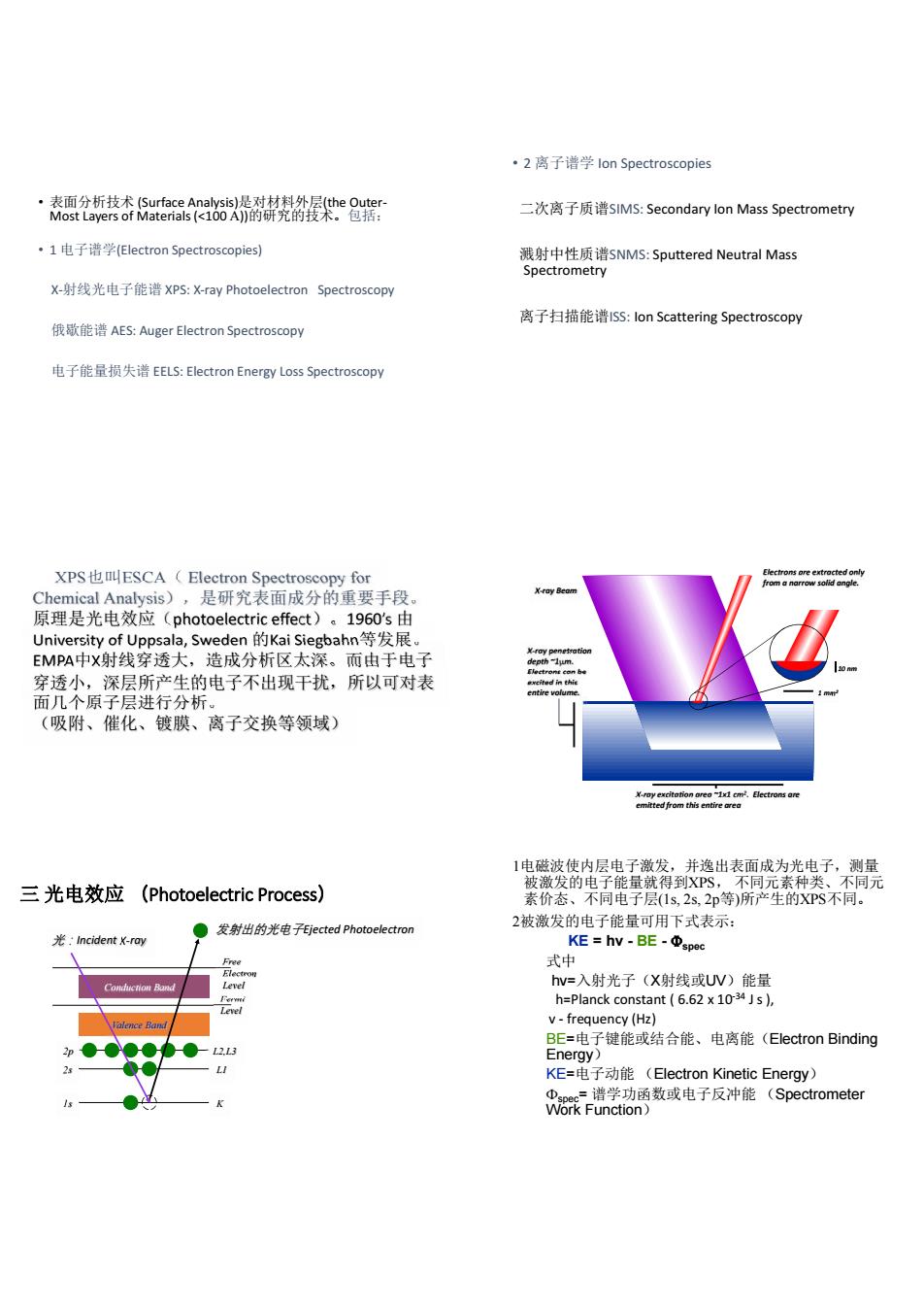正在加载图片...

·2离子谱学on Spectroscopies 素分析技es是装路屋果eu 二次离子质i谱sIM5:Secondary lon Mass Spectrometry ·1电子话学5 pe】 a中性质满sNMs:5 pere NeutralMass X-射线光电子能谱XPs:X-ray Photoelectron Spectroscopy 俄能谱AES:Auger Electron Spectroscopy 离子扫描能谱ss:lon Scattering Spectroscopy 电子能量损失谱EL5:Electron Energy Loss Spectroscopy 。1960s 的建 生的电子不出现干扰,所以可对表 (吸附、催化、镀膜、离子交换等领域) 三光电效应(Photoelectric Process) 费资电卧电五获機出无不测 素价态、不同电子层52p等)所产生的XS不同。 2被激发的电子能量可用下式表示。 ent K-fo h=Planck constant (6.62x14Js)• 表面分析技术 (Surface Analysis)是对材料外层(the Outer- Most Layers of Materials(<100 ))的研究的技术。包括: • 1 电子谱学(Electron Spectroscopies) X-射线光电子能谱 XPS: X-ray Photoelectron Spectroscopy 俄歇能谱 AES: Auger Electron Spectroscopy 电子能量损失谱 EELS: Electron Energy Loss Spectroscopy • 2 离子谱学 Ion Spectroscopies 二次离子质谱SIMS: Secondary Ion Mass Spectrometry 溅射中性质谱SNMS: Sputtered Neutral Mass Spectrometry 离子扫描能谱ISS: Ion Scattering Spectroscopy XPS也叫ESCA( Electron Spectroscopy for Chemical Analysis),是研究表面成分的重要手段。 原理是光电效应(photoelectric effect)。1960’s 由 University of Uppsala, Sweden 的Kai Siegbahn等发展。 EMPA中X射线穿透大,造成分析区太深。而由于电子 穿透小,深层所产生的电子不出现干扰,所以可对表 面几个原子层进行分析。 (吸附、催化、镀膜、离子交换等领域) X-ray Beam X-ray penetration depth ~1 m. Electrons can be excited in this entire volume. X-ray excitation area ~1x1 cm2. Electrons are emitted from this entire area Electrons are extracted only from a narrow solid angle. 1 mm2 10 nm Conduction Band Valence Band L2,L3 L1 K Fermi Level Free Electron Level 光:Incident X-ray 发射出的光电子Ejected Photoelectron 1s 2s 2p 1电磁波使内层电子激发,并逸出表面成为光电子,测量 被激发的电子能量就得到XPS, 不同元素种类、不同元 素价态、不同电子层(1s, 2s, 2p等)所产生的XPS不同。 2被激发的电子能量可用下式表示: KE = hv - BE - spec 式中 hv=入射光子(X射线或UV)能量 h=Planck constant ( 6.62 x 10-34 J s ), v - frequency (Hz) BE=电子键能或结合能、电离能(Electron Binding Energy) KE=电子动能 (Electron Kinetic Energy) spec= 谱学功函数或电子反冲能 (Spectrometer Work Function)